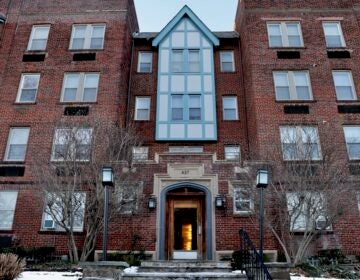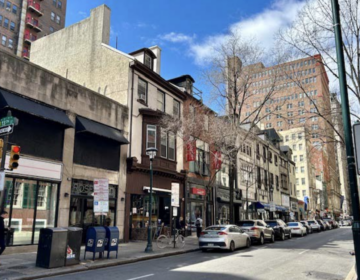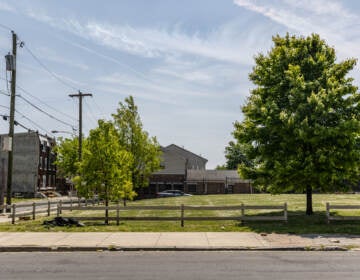Philly Historical Commission official resigns, says Kenney meddled in vote over LGBTQ, African American landmark
The former Historical Commission member said the Kenney administration pressured him to vote against the protection of the former 12th Street Gym building on 12th Street.

The Gloria Casarez mural by Michelle Angela Ortiz at 12th and Locust streets was painted over on Wednesday, December 23, 2020. (Photo by Steve Weinik/Mural Arts)
A city employee who serves on the Philadelphia Historical Commission has resigned from his job and commission post with an accusation that Mayor Jim Kenney’s administration pressured him to vote against the historic certification of a site of LGBTQ and Black history on behalf of a developer.
Josh Lippert, a manager with the city’s Department of Licenses & Inspections, had served as that department’s designee on the historical commission since early 2019. But at a meeting last week, Lippert announced he intended to resign over what he described as a pattern of interference from the Mayor’s Office.
Lippert singled out a 2019 vote over an effort to nominate the former 12th Street Gym property on 12th Street at Locust Street to the city’s historic register to stave off plans to demolish and redevelop the site into a 448-unit tower. The multi-property site included a building that was home to 19th century abolitionist Henry Minton and the Camac Baths — one of the first Jewish and, later, LGBT-friendly bathhouses in the city — as well as a mural to gay rights activist Gloria Casarez painted by artist Michelle Angela Ortiz.
Ahead of that commission vote, Lippert said former L&I commissioner David Perri approached him and advised him to vote against the historic nomination.
“The commissioner sat me down in his office and made it explicit that this was the administration’s wishes,” he said.
Lippert said Perri left the final vote up to him, the message was clear: The developer, Midwood Investment and Development, a New York company, wanted to clear the site and the Mayor’s Office supported that plan over the desire of Philadelphians who wanted to see the historic building preserved.
Paul Chrystie, a spokesperson for the city, disputed that Perri had directed Lippert on how to vote, but maintained there would be nothing inappropriate about such an exchange. Five city departments have designees on the 12-member commission and those department heads report to the mayor.
“There is nothing untoward about a Commissioner instructing his representative about how to represent him,” he said. “Accordingly, in those cases in which the administration has a position on a proposed designation before [the historical commission], those departments are expected to be receptive to that position.”
Lippert ultimately split the difference: voting in favor of nominating the Camac Baths while abstaining from voting on two other properties comprising the site, including the former Minton home –– an action he regards today as an effective “no” vote.
In the end, the bathhouse was approved, but not the two other properties.
Chrystie noted Lippert never formally reported his concerns and did not face repercussions for his actions, despite not voting against all three properties.
“The ‘pressure’ could not have been all that intense,” he said.
However, the former designee said the experience and his own actions troubled him, given the stated purpose of the commission and his service on the Mayor’s Historic Preservation Task Force, which was expressly created to proactively identify and preserve more historic buildings.
“Behind the scenes I was being directed to vote no,” he said. “It was incongruous with the goals of the Historic Preservation Task Force.”
Faye Anderson, a local preservationist who supported the 12th Street Gym nominations and has long criticized the city’s nomination efforts, said preservationists largely viewed many commission designees as effectively carrying out the wishes of the administration and long suspected many votes were steered toward the benefit of developers.
“They’re seat warmers,” she said of the designees. “And I have a bridge for sale if anyone thinks they’re voting independently from their boss. What’s shocking about this is that [Lippert] actually said it.”
In addition to leaving the historical commission, Lippert, who has overseen flood mitigation efforts for the city, is also set to leave that position in November to take a job with the Federal Emergency Management Agency. Explaining this decision, Lippert analogized his experience with the historical commission to flood abatement efforts –– identifying areas to exclude from development or buying out existing properties as a flood abatement strategy.
He said these efforts also received little funding or institutional prioritization from the Kenney administration, which Lippert said owed to key economic centers, like the Navy Yard, sitting in the floodplain.
“Even after Hurricane Ida there was never a release from the administration saying that they really want to tackle that issue,” he said. “So, just like my work with flood plains, I think the frictions between politics and the desire for development are at play with historic preservation.”

Subscribe to PlanPhilly
WHYY is your source for fact-based, in-depth journalism and information. As a nonprofit organization, we rely on financial support from readers like you. Please give today.









